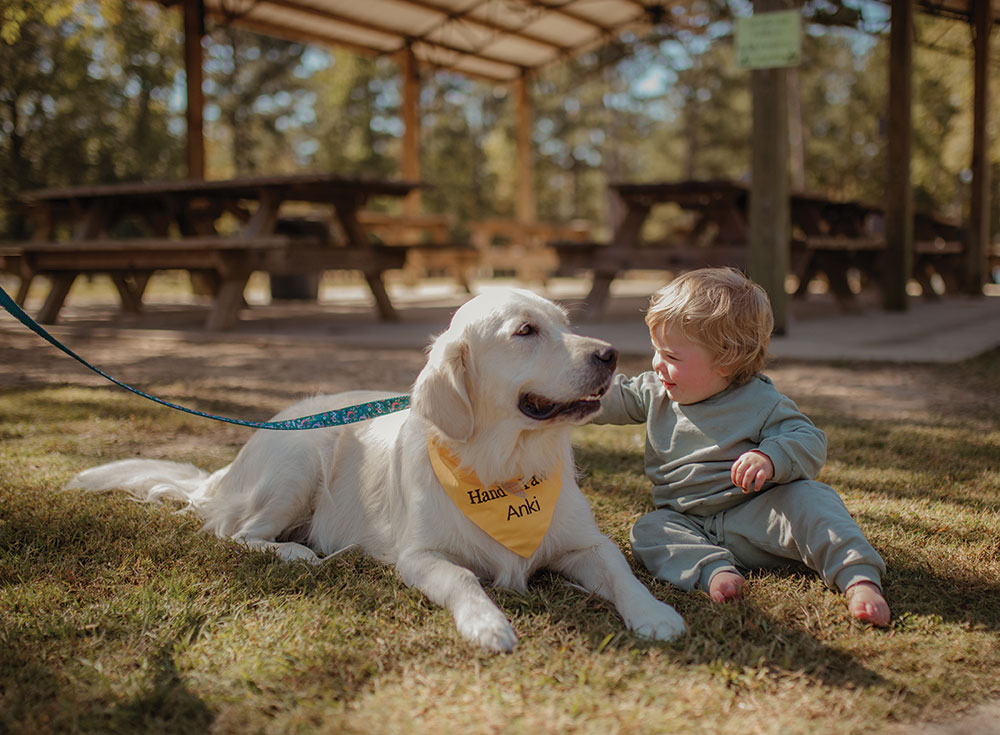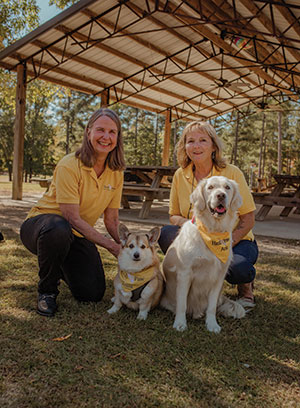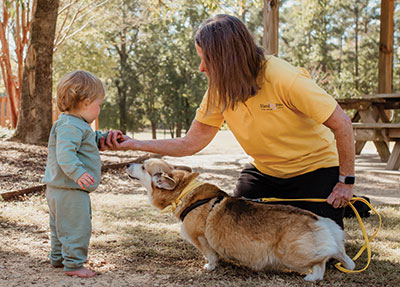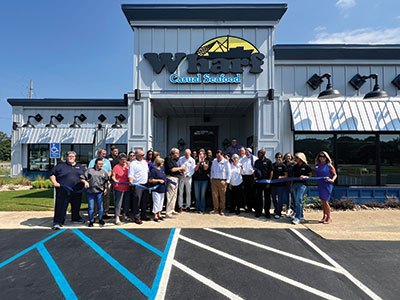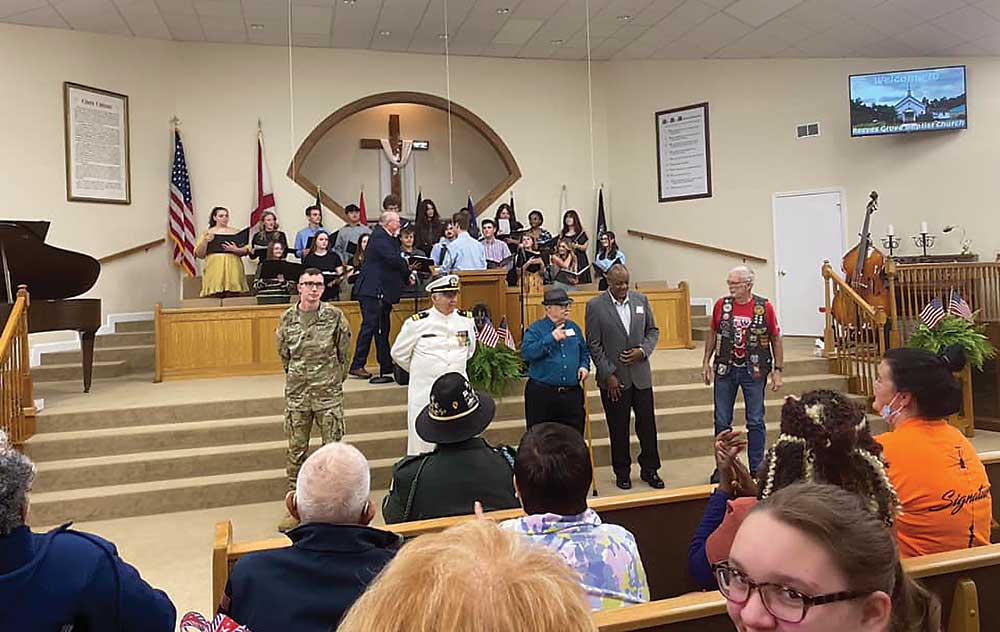Animal-assisted therapy teams from St. Clair County
Story by Roxann Edsall
Photos by Mackenzie Free
Submitted photos
Four paws, one wet nose, a wagging tail, and two expressive eyes can turn a day around. Just ask Anki, an 80-pound crème golden retriever. She’ll even throw in a full body hug to complete the comfort package.
Two-year-old Anki is a natural at her work. She and her human, Daniella Cook, serve as ambassadors for Hand in Paw (HIP), an organization that offers animal therapy in the Greater Birmingham area.
When Anki was just a puppy, Cook’s veterinarian commented that she was exceptionally calm for her breed. Later, as they attended puppy obedience classes, the instructor commented on how she seemed like an “old soul” in a puppy body.
“Then a cycling buddy of mine asked me if I’d ever heard of Hand in Paw,” said Cook. “Anki was just six months old at the time and the minimum age for a dog is 18 months to be a part of that organization.”
So, Cook used the next year to research the steps to becoming a therapy team for Hand in Paw. Successfully completing obedience classes was just the first step. “We went on to take a Good Citizen dog class,” said Cook. “There are 10 benchmarks you must meet and if you miss one, you’re out. She got them all, despite it being an adoption day at the pet store where she performed for her final Good Citizen evaluation.”
Cook, who works in Pell City at WKW, a German company that supplies auto parts, occasionally brought Anki to work with her. She noticed the effect her dog had on others around her. “We had a plant manager who had had a really rough day,” Cook recalls. “He asked if he could hug her, and in five minutes you could see a difference in him. He asked if I could bring her in once a week.”
At 18 months old, Anki was ready to be evaluated to partner with Cook as an official therapy team. Stephanie Stoltzner is the volunteer and program manager for HIP. “We take them through a four-week workshop, then evaluate them to make sure they can deal with outside influences and the many things that can happen in the environment they would be working in,” explains Stoltzner. Anki and Cook passed with flying colors and received their new uniforms – a bright yellow bandana for Anki and a matching yellow shirt for Cook.
Cook’s face lights up as she shares details of some of the animal therapy experiences the pair have been party to. Recently the duo was sent to the Exceptional Foundation in Birmingham, an organization that provides social and recreational services for adults and children with intellectual disabilities. Cook and Anki were positioned in the center of the room, and each person had an opportunity to interact with the beautiful pup and her owner.
“On this day, there were all adult clients,” recounts Cook. “When they saw Anki, their faces lit up, and they talked about their own dogs. One client told me how she trained her dog and asked if she could train Anki. Anki leaned into her in a hug and just made her day. I still get goose bumps thinking about it! I was just so proud to have this dog and to be able to make a difference.”
Cook and Anki are the second HIP team from St. Clair County. Kelli Agnew and her seven-year-old corgi, Tessa, have been a busy Hand in Paw team for over two years. This is Agnew’s 13th year as a volunteer for HIP. Tessa is her second therapy dog.
Her first pet therapy partner was a Pell City animal shelter rescue cat named Asher. One of her most memorable therapy moments involved Asher and a visit to a memory care facility. “We were visiting with a lady who would not speak; she hadn’t spoken since she’d been there,” Agnew remembers. “This lady was so happy to see Asher and started making happy noises to this cat. The nurses were shocked that she was communicating with him.”
After Asher passed, Agnew spent five years as a Hand in Paw team with her corgi, Oliver, working with the child and adolescent psychiatry unit at UAB. They also participated in the organization’s delivery of the Sit, Stay, Read! program, an animal-assisted reading program for early education. This program has shown great success in encouraging reluctant readers to read to an animal companion.
Five years after Oliver passed, Agnew adopted Tessa, another corgi, this time a Pembroke Welsh and former show dog. Having had experience with the animal dispositions that make for good therapy pets, she saw something special in Tessa. “You could tell from the beginning that she was going to be a great therapy dog,” said Agnew. “You take her anywhere, and she instantly goes to people. She just loves everybody.”
It’s that temperament that helps deliver effective animal-assisted therapy. In a 2008 study by the National Institutes of Health, human interaction with pets was shown to reduce stress, improve mood, lower blood pressure and to reduce anxiety.
In 1996, Beth Franklin, a Birmingham native and animal advocate, started Hand in Paw to improve the health and wellbeing of people through interaction with pets. She was serving as executive director of the Greater Birmingham Humane Society and worked with juveniles who were serving court-mandated community service.
Intended simply to provide help to animals in need, the program had an unexpected benefit. Franklin was struck by the positive behavioral changes to the volunteers because of their interactions with the animals.
In the 28 years since its founding, Hand in Paw has become a national leader in the growing field of animal-assisted therapy. They now have 92 owner/pet teams, who go out to a variety of intervention sites, including universities, hospitals, nursing homes, veterans’ homes, schools, physical therapy facilities, hospice and respite care and libraries. They also offer first-responder decompression visits.
“We’ve been to the Birmingham Police Department during shift change,” said Cook. “I’ve seen officers get down on the floor with Anki. They come by to say hello as they’re leaving to go home and as they are arriving for shift.” Agnew and Tessa spend some of their volunteer time working with clients at the Bruno Cancer Center, Girls, Inc., and at Lakeshore Foundation.
Stephanie Stoltzner has been working with Hand in Paw since long before she worked there. She has a team of two dogs, Olive, a mix who looks like a golden retriever and Fern, another mix, who Stoltzner describes as looking like “she stuck her tongue in a light socket.” Their greatest reward as a therapy team, she says, is the people. “It doesn’t matter how bad a day I’m having,” she says. “I see the pure joy and happiness people get from seeing the dogs. Now I work here and get to work with my dogs all the time. it’s a dream.”
Anki and Tessa know that when they get bathed and fitted with their yellow bandanas, it’s time to go to work. Both Cook and Agnew say they seem to know they’re “on” and take matters seriously.
Spreading joy and encouragement is serious business. Paws down.
Editor’s note: Hand in Paw is a 501(c)3 nonprofit and survives on donations and grants. There is never a charge for their services. If you are interested in working with them or helping with their mission, contact Hand in Paw at handinpaw.org.











